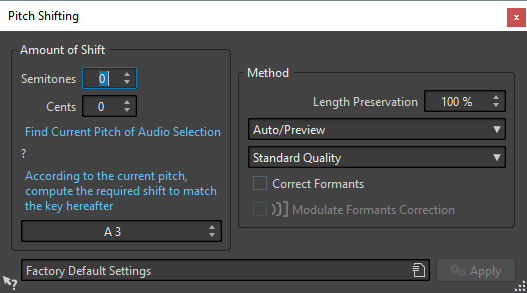Pitch Shifting Dialog
In this dialog, you can change the pitch of a sound.
-
To open the Pitch Shifting dialog, select the Process tab in the Audio Editor, and click Pitch Shifting in the Time & Pitch section.
This dialog is also available as a monopass plug-in in the Batch Processor window.

- Semitones
-
Specifies the amount of pitch change in semitones.
- Cents
-
Specifies the amount of pitch change in cents.
- Find Current Pitch of Audio Selection
-
Analyzes the pitch of the selected audio and displays it below this button.
- According to the current pitch, compute the required shift to match the key hereafter
-
Click to adjust Amount of Pitch parameters automatically, based on the detected pitch and the pitch specified in the value field below this button.
- Pitch field
-
Specifies the resulting pitch.
- Length Preservation
-
Specifies how the length of the selection is affected by the operation:
-
A setting of 100 means that the length of the audio remains unchanged.
-
A setting of 0 means that the program behaves like a tape recorder, when the speed of its tape is changed. For example, if you raise the pitch by one octave, the audio is half as long.
-
Intermediate values give results in between these two extremes.
For large transposition values, the lower this setting, the better the quality of the effect.
-
- Method pop-up menu
-
Auto/Preview: Automatically selects the best time/frequency trade-off for real-time/preview performance. This is the fastest setting, but might not provide optimal results in all cases.
Time Localization ++ (Instruments, Voices): Selects full time localization. This is a good setting for single instruments and solo voices.
Time Localization +: Selects the time/frequency localization with the emphasis on time localization. If the previous mode produces echo artifacts, try this option.
Average Time/Frequency Localization: Sets the time/frequency localization halfway between the time and frequency domains. It is the best setting for all general purpose signals.
Frequency Localization +: Selects the time/frequency localization with the emphasis on frequency localization. This is a good setting for classical music.
Frequency Localization ++ (Complex Mixes): Selects the highest possible frequency localization. This setting might not work well on material with many sharp attack transients, but it can produce good results with less transient/percussive material.
Transcribe Mode (for Large Changes): This uses a content-aware algorithm to time-stretch and pitch-shift music by up to 4 times the original length without losing information critical to transcription, such as attack transients.
- Quality pop-up menu
-
The High Quality and Best (Slow) modes provide high-quality time stretching, but the processing takes longer. For most uses, the Standard Quality mode is sufficient.
- Correct Formants
-
If this option is activated, changing the pitch of vocal material gives a more realistic result. When processing non-vocal material, leave this option deactivated, because it uses a slightly slower processing algorithm.
NoteThis algorithm might cause a noticeable increase in signal level.
- Modulate Formants Correction
-
If this option is activated, the formant correction is modulated over time.
NoteIf the envelope is not used and the formant correction is activated, a 100 % correction is performed.